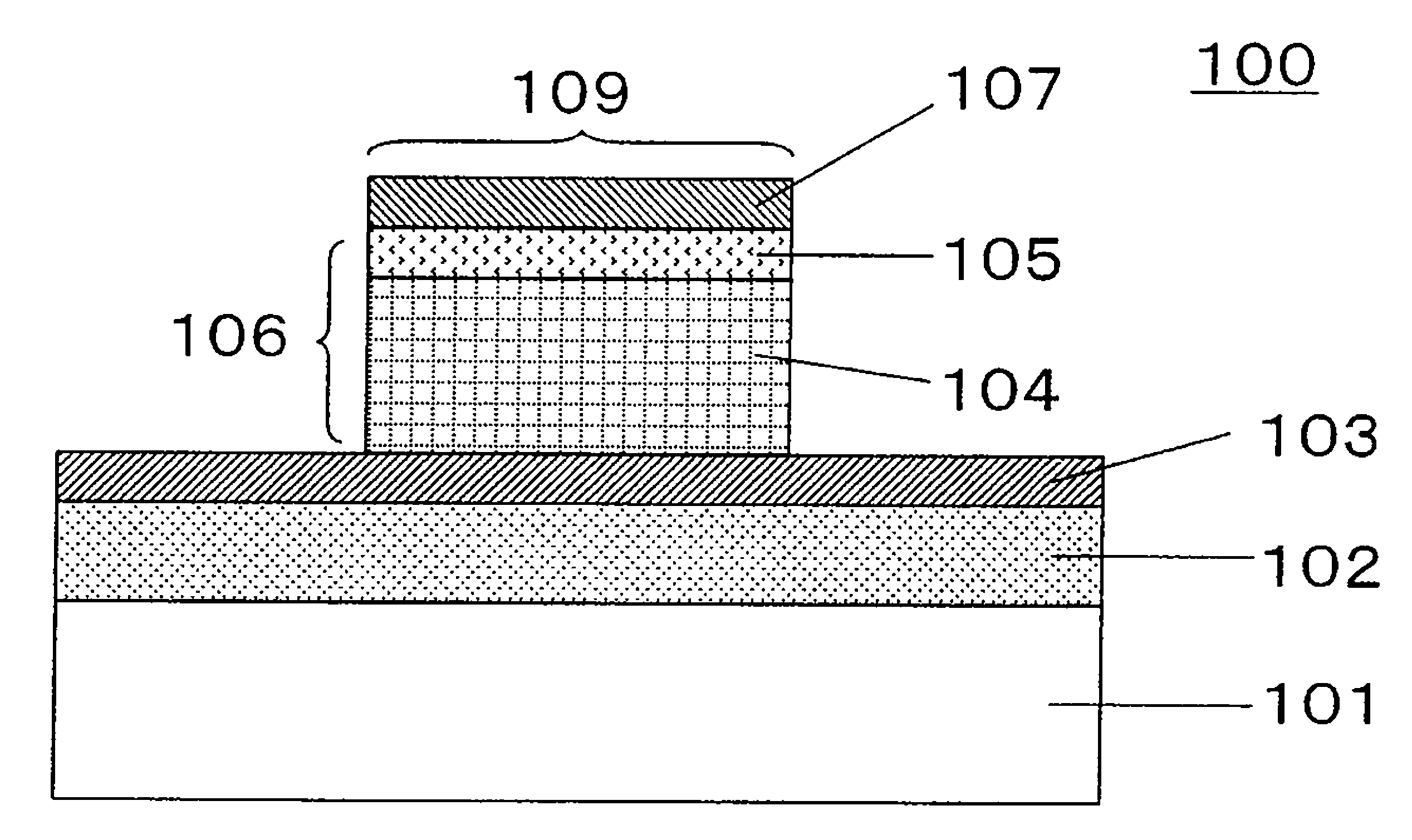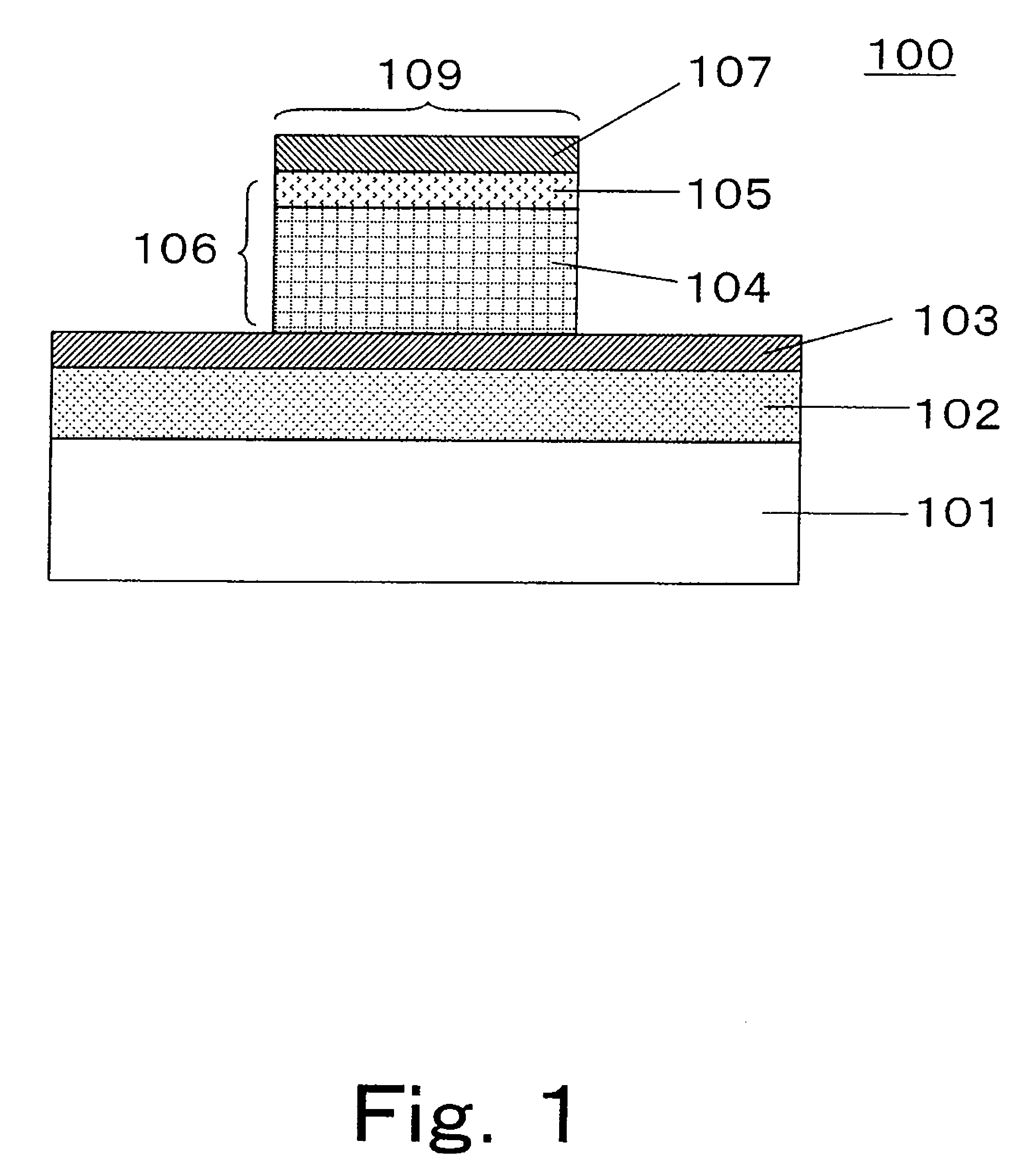Nonvolatile memory element, manufacturing method thereof, and nonvolatile semiconductor apparatus using the nonvolatile memory element
a nonvolatile memory element and manufacturing method technology, applied in the direction of digital storage, semiconductor/solid-state device details, instruments, etc., can solve the limitation of the miniaturization of an existing flash memory using a floating gate, and achieve the desirable resistance value retention characteristics, high affinity, and rewrite characteristics that are reversibly stabl
- Summary
- Abstract
- Description
- Claims
- Application Information
AI Technical Summary
Benefits of technology
Problems solved by technology
Method used
Image
Examples
embodiment 1
[Configuration of Nonvolatile Memory Element]
[0083]FIG. 1 is a cross-sectional view showing an example of a configuration of a nonvolatile memory element according to Embodiment 1 of the present invention.
[0084]As shown in FIG. 1, a nonvolatile memory element 100 of this embodiment comprises a substrate 101, an oxide layer 102 formed on the substrate 101, a first electrode layer 103 formed on the oxide layer 102, a second electrode layer 107, and a resistance variable layer 106 sandwiched between the first electrode layer 103 and the second electrode layer 107. The resistance variable layer 106 comprises an oxygen-deficient tantalum oxide having a composition represented by TaOz (0106 comprises a first tantalum-containing layer (first region: hereinafter referred to as “first tantalum oxide layer”) 104 having a low oxygen content rate, and a second tantalum-containing layer (second region: hereinafter referred to as “second tantalum oxide layer) 105 formed on the first tantalum oxid...
embodiment 2
[0154]In Embodiment 1, after the first tantalum oxide layer was deposited inside the sputtering apparatus, oxidation treatment using oxygen plasma was subsequently performed to form the second tantalum oxide layer. In this method, however, a thick second tantalum oxide layer was not be able to be formed because of the used apparatus. Therefore, in Embodiment 2, the operation of a nonvolatile memory element having a thick second tantalum oxide layer will be described.
[Method of Manufacturing Nonvolatile Memory Element]
[0155]The method of manufacturing the nonvolatile memory element is fundamentally identical to that of Embodiment 1. However, for the convenience of the oxidation process, the deposition condition of the tantalum oxide and the size of the manufactured nonvolatile memory element are different from those of Embodiment 1. Hereinafter, the process of manufacturing the nonvolatile memory element will be described with reference to FIG. 2.
[0156]Initially, as shown in FIG. 2(a...
embodiment 3
[0174]In the above described nonvolatile memory element 100 according to Embodiment 1, the oxygen content rate of the first tantalum oxide layer 104 was 58 at % (TaO1.4). The oxygen content rate of the first tantalum oxide layer 104 in the nonvolatile memory element 100 according to Embodiment 2 was close to that of Embodiment 1, i.e., 61 at % (TaO1.6). In contrast, a nonvolatile memory element according to Embodiment 3 includes a first tantalum oxide layer whose oxygen content rate is varied in a little larger range. Since the other constituents of Embodiment 3 are identical to those of Examples 1 and 2, illustration thereof will be omitted. Hereinafter, a description will be made of the manufacturing methods and the resistance varying characteristics of Examples in this embodiment which are manufactured in such a way that the oxygen content rate of the first tantalum oxide layer is changed, with reference to FIG. 1.
[Relation Between Oxygen Flow Rate Ratio During Sputtering and Com...
PUM
 Login to View More
Login to View More Abstract
Description
Claims
Application Information
 Login to View More
Login to View More - R&D
- Intellectual Property
- Life Sciences
- Materials
- Tech Scout
- Unparalleled Data Quality
- Higher Quality Content
- 60% Fewer Hallucinations
Browse by: Latest US Patents, China's latest patents, Technical Efficacy Thesaurus, Application Domain, Technology Topic, Popular Technical Reports.
© 2025 PatSnap. All rights reserved.Legal|Privacy policy|Modern Slavery Act Transparency Statement|Sitemap|About US| Contact US: help@patsnap.com



